tow Hyundai Getz 2003 Owner's Guide
[x] Cancel search | Manufacturer: HYUNDAI, Model Year: 2003, Model line: Getz, Model: Hyundai Getz 2003Pages: 444, PDF Size: 13.82 MB
Page 171 of 444
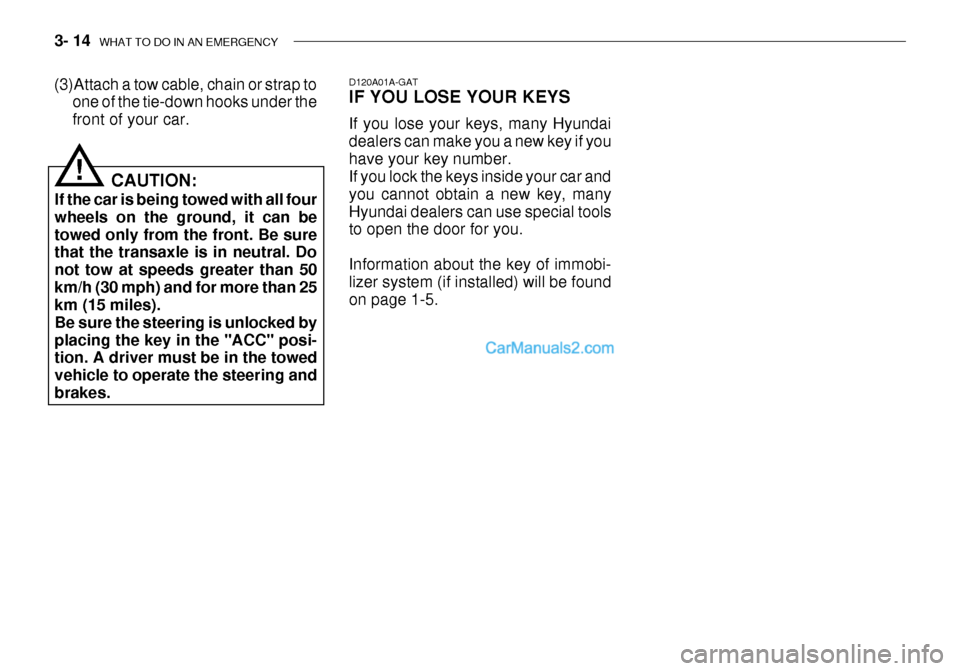
3- 14 WHAT TO DO IN AN EMERGENCY
D120A01A-GAT IF YOU LOSE YOUR KEYS If you lose your keys, many Hyundai dealers can make you a new key if youhave your key number. If you lock the keys inside your car and you cannot obtain a new key, manyHyundai dealers can use special tools to open the door for you. Information about the key of immobi- lizer system (if installed) will be found on page 1-5.
CAUTION:
If the car is being towed with all fourwheels on the ground, it can betowed only from the front. Be sure that the transaxle is in neutral. Do not tow at speeds greater than 50km/h (30 mph) and for more than 25 km (15 miles). Be sure the steering is unlocked byplacing the key in the "ACC" posi- tion. A driver must be in the towed vehicle to operate the steering andbrakes.
!
(3)Attach a tow cable, chain or strap to
one of the tie-down hooks under the front of your car.
Page 184 of 444

VEHICLE MAINTENANCE REQUIREMENTS 5- 7
SEVERE DRIVING CONDITIONS
A - Repeated short distance driving
B - Extensive idling
C - Driving in dusty, rough roads
D - Driving in areas using salt or other corrosive
materials or in very cold weather
E - Driving in sandy areas F - More than 50% driving in heavy city traffic during hot weather
above 32°C (90°F)
G - Driving in mountainous areas
H - Towing a trailer
I - Driving for patrol car, taxi, commercial car or vehicle towing
J - Driving over 170 Km/h (100 MPH) R R RR
I I I I
RR R
European community Only Except European community
ENGINE OIL AND FILTER AIR CLEANER FILTER SPARK PLUGSTIMING BELT BRAKE PADS, CALIPERS AND ROTORS REAR BRAKE DRUMS/LININGS/PADS,PARKING BRAKE STEERING GEAR BOX, LINKAGE & BOOTS/LOWER ARM BALL JOINTDRIVESHAFTS AND BOOTS MANUAL TRANSAXLE OIL AUTOMATIC TRANSAXLEFLUID
AIR FILTER (For Evaporator and Blower unit)
F040A06A-GAT
MAINTENANCE UNDER SEVERE USAGE CONDITIONS
The following items must be serviced more frequently on cars normally used under severe driving conditions. Refer to the chart below for the appropriate maintenance intervals. R : Replace I : Inspect and, after inspection, clean, adjust, repair or replace if necessary
MAINTENANCE ITEM
EVERY 7,500 KM OR 6 MONTHS MORE FREQUENTLY MORE FREQUENTLYEVERY 60,000 KM OR 48 MONTHS MORE FREQUENTLY MORE FREQUENTLY MORE FREQUENTLY EVERY 15,000 KM OR 12 MONTHS EVERY 100,000 KM EVERY 45,000 KMEVERY 40,000 KM MORE FREQUENTLY A, B, C, F, HC, E B, HD, E, F, G C, D, G, H C, D, G, H C, D, E, F C, D, E, F A, C, D, E, F, G, H, I, J A, C, E, F, G, H, I C, E
MAINTENANCE
INTERVALS DRIVING
CONDITION
MAINTENANCE
OPERATION
Page 215 of 444

DO-IT-YOURSELF MAINTENANCE 6- 27
CAUTION:
When replacing a fusible link, never use anything but a new fusible link with the same or lower amperage rating. Never use a piece of wire ora higher-rated fusible link. This could result in serious damage and create a fire hazard.!
4. Replace the blown fuse by pressing a new fuse of the same rating into place. The fuse should be a snug fit. If it is not, have the fuse clip repairedor replaced by a Hyundai dealer. If you do not have a spare fuse, you may be able to borrow a fuse of thesame or lower rating from an acces-
G200B02A-AAT Replacing Accessory Fuse The fuse box for the lights and other electrical accessories will be found low on the dashboard on the driver's side.Inside the box you will find a list show- ing the circuits protected by each fuse. If any of your car's lights or otherelectrical accessories stop working, a blown fuse could be the reason. If the fuse has burned out, you will see thatthe metal strip inside the fuse has burned through. If you suspect a blown fuse, follow this procedure:
HTB180
1. Turn off the ignition and all other
switches.
2. Open the fuse box and examine each fuse. Remove each fuse by pulling it toward you (a small "fuse puller" tool is contained in the fusebox to simplify this operation).
3. Be sure to check all other fuses
even if you find one that appears tohave burned out.
HTB223
Page 223 of 444
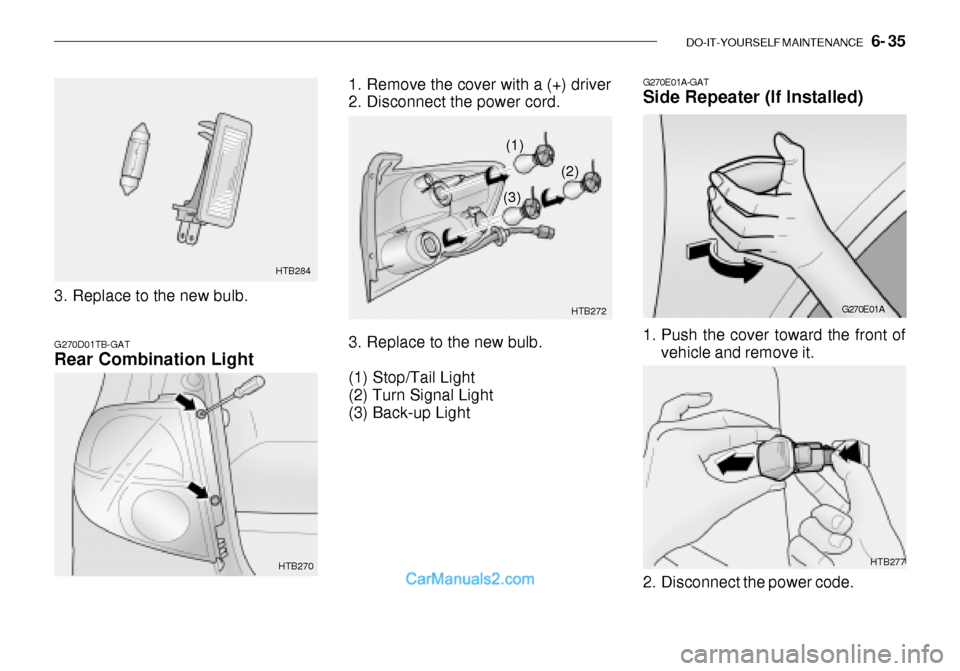
DO-IT-YOURSELF MAINTENANCE 6- 35
3. Replace to the new bulb. HTB284
G270D01TB-GAT Rear Combination Light
HTB270
HTB277
1. Remove the cover with a (+) driver
2. Disconnect the power cord.
3. Replace to the new bulb. (1) Stop/Tail Light (2) Turn Signal Light (3) Back-up LightHTB272G270E01A-GAT Side Repeater (If Installed)
G270E01A
(1)
(2)
(3)
1. Push the cover toward the front ofvehicle and remove it.
2. Disconnect the power code.
Page 238 of 444
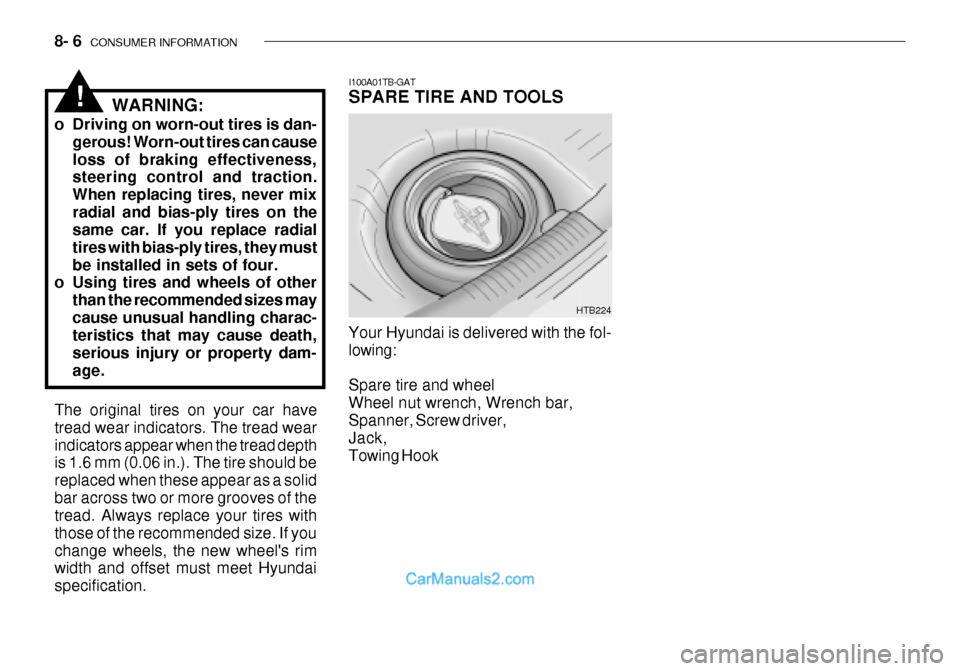
8- 6 CONSUMER INFORMATION
I100A01TB-GAT SPARE TIRE AND TOOLS Your Hyundai is delivered with the fol- lowing: Spare tire and wheel Wheel nut wrench, Wrench bar, Spanner, Screw driver, Jack,Towing Hook HTB224
WARNING:
o Driving on worn-out tires is dan- gerous! Worn-out tires can causeloss of braking effectiveness, steering control and traction.
When replacing tires, never mixradial and bias-ply tires on the same car. If you replace radial tires with bias-ply tires, they mustbe installed in sets of four.
o Using tires and wheels of other
than the recommended sizes maycause unusual handling charac- teristics that may cause death, serious injury or property dam-age.
!
The original tires on your car have tread wear indicators. The tread wearindicators appear when the tread depth is 1.6 mm (0.06 in.). The tire should be replaced when these appear as a solidbar across two or more grooves of the tread. Always replace your tires with those of the recommended size. If youchange wheels, the new wheel's rim width and offset must meet Hyundai specification.
Page 247 of 444
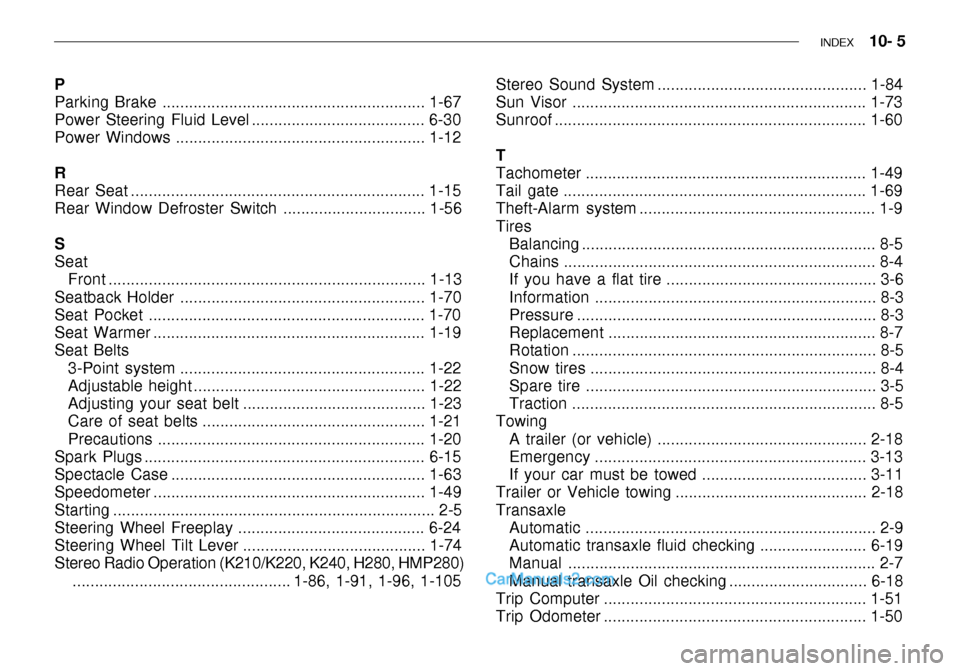
INDEX 10- 5
P
Parking Brake ........................................................... 1-67
Power Steering Fluid Level ....................................... 6-30
Power Windows ........................................................ 1-12 R
Rear Seat .................................................................. 1-15
Rear Window Defroster Switch ................................ 1-56 S Seat
Front ....................................................................... 1-13
Seatback Holder ....................................................... 1-70
Seat Pocket .............................................................. 1-70
Seat Warmer ............................................................. 1-19 Seat Belts 3-Point system ....................................................... 1-22
Adjustable height .................................................... 1-22
Adjusting your seat belt ......................................... 1-23
Care of seat belts .................................................. 1-21
Precautions ............................................................ 1-20
Spark Plugs ............................................................... 6-15
Spectacle Case ......................................................... 1-63
Speedometer ............................................................. 1-49
Starting ........................................................................ 2-5
Steering Wheel Freeplay .......................................... 6-24
Steering Wheel Tilt Lever ......................................... 1-74 Stereo Radio Operation (K210/K220, K240, H280, HMP280)
................................................. 1-86, 1-91, 1-96, 1-105 Stereo Sound System ............................................... 1-84
Sun Visor .................................................................. 1-73
Sunroof ...................................................................... 1-60 T
Tachometer ............................................................... 1-49
Tail gate .................................................................... 1-69
Theft-Alarm system ..................................................... 1-9 Tires
Balancing .................................................................. 8-5
Chains ...................................................................... 8-4
If you have a flat tire ............................................... 3-6
Information ............................................................... 8-3
Pressure ................................................................... 8-3
Replacement ............................................................ 8-7
Rotation .................................................................... 8-5
Snow tires ................................................................ 8-4
Spare tire ................................................................. 3-5
Traction .................................................................... 8-5
Towing
A trailer (or vehicle) ............................................... 2-18
Emergency ............................................................. 3-13
If your car must be towed ..................................... 3-11
Trailer or Vehicle towing ........................................... 2-18Transaxle Automatic ................................................................. 2-9
Automatic transaxle fluid checking ........................ 6-19
Manual ..................................................................... 2-7
Manual transaxle Oil checking ............................... 6-18
Trip Computer ........................................................... 1-51
Trip Odometer ........................................................... 1-50
Page 250 of 444
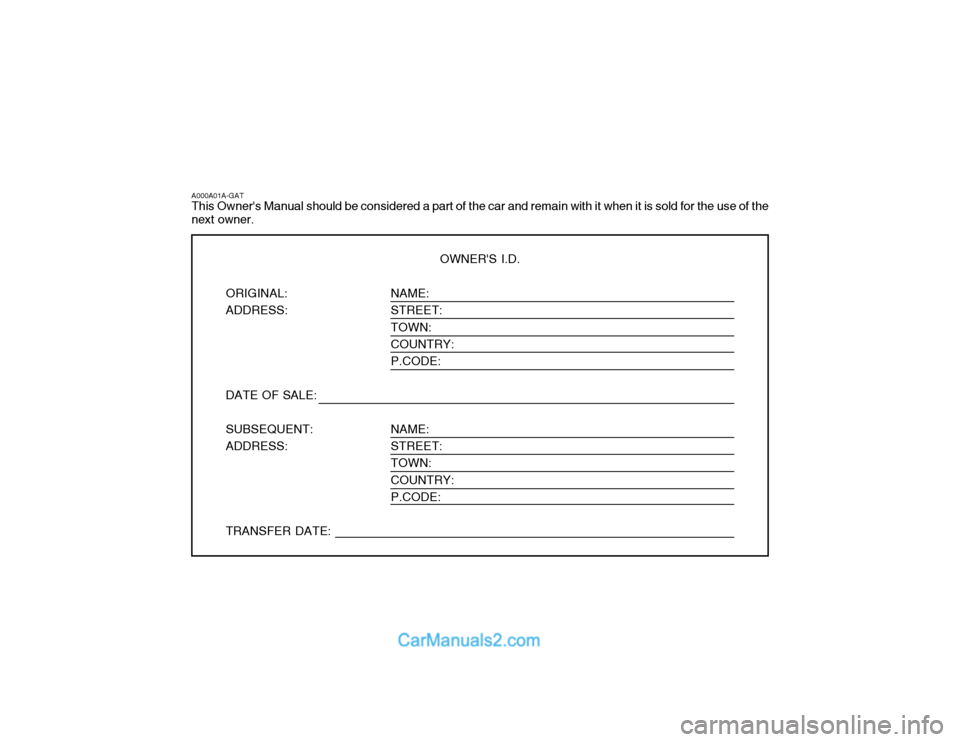
NAME: STREET:TOWN: COUNTRY: P.CODE: NAME: STREET: TOWN:COUNTRY: P.CODE:
A000A01A-GAT This Owner's Manual should be considered a part of the car and remain with it when it is sold for the use of the next owner.OWNER'S I.D.
ORIGINAL: ADDRESS: DATE OF SALE: SUBSEQUENT: ADDRESS: TRANSFER DATE:
Page 263 of 444
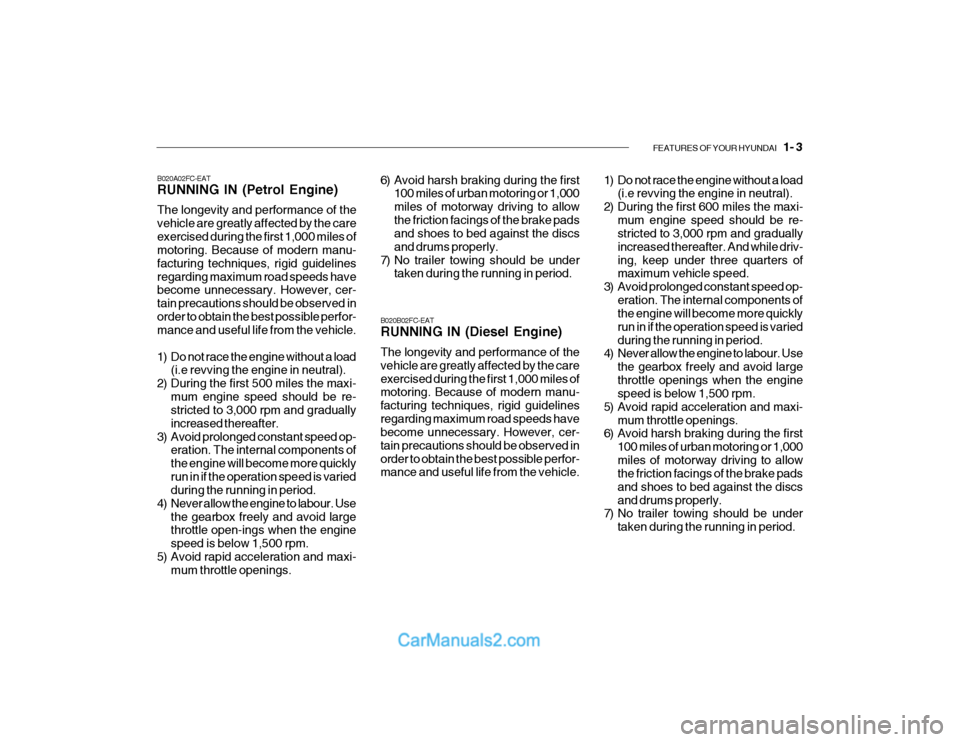
FEATURES OF YOUR HYUNDAI 1- 3
B020A02FC-EAT RUNNING IN (Petrol Engine) The longevity and performance of the vehicle are greatly affected by the careexercised during the first 1,000 miles of motoring. Because of modern manu- facturing techniques, rigid guidelinesregarding maximum road speeds have become unnecessary. However, cer- tain precautions should be observed inorder to obtain the best possible perfor- mance and useful life from the vehicle.
1) Do not race the engine without a load
(i.e revving the engine in neutral).
2) During the first 500 miles the maxi- mum engine speed should be re- stricted to 3,000 rpm and gradually increased thereafter.
3) Avoid prolonged constant speed op- eration. The internal components ofthe engine will become more quicklyrun in if the operation speed is varied during the running in period.
4) Never allow the engine to labour. Use the gearbox freely and avoid largethrottle open-ings when the engine speed is below 1,500 rpm.
5) Avoid rapid acceleration and maxi- mum throttle openings. 6) Avoid harsh braking during the first
100 miles of urban motoring or 1,000miles of motorway driving to allowthe friction facings of the brake pads and shoes to bed against the discs and drums properly.
7) No trailer towing should be under taken during the running in period.
B020B02FC-EAT RUNNING IN (Diesel Engine) The longevity and performance of the vehicle are greatly affected by the care exercised during the first 1,000 miles of motoring. Because of modern manu- facturing techniques, rigid guidelinesregarding maximum road speeds have become unnecessary. However, cer- tain precautions should be observed inorder to obtain the best possible perfor- mance and useful life from the vehicle. 1) Do not race the engine without a load
(i.e revving the engine in neutral).
2) During the first 600 miles the maxi- mum engine speed should be re-stricted to 3,000 rpm and gradually increased thereafter. And while driv-ing, keep under three quarters of maximum vehicle speed.
3) Avoid prolonged constant speed op- eration. The internal components ofthe engine will become more quickly run in if the operation speed is variedduring the running in period.
4) Never allow the engine to labour. Use
the gearbox freely and avoid largethrottle openings when the engine speed is below 1,500 rpm.
5) Avoid rapid acceleration and maxi-
mum throttle openings.
6) Avoid harsh braking during the first
100 miles of urban motoring or 1,000 miles of motorway driving to allow the friction facings of the brake pads and shoes to bed against the discsand drums properly.
7) No trailer towing should be under
taken during the running in period.
Page 265 of 444
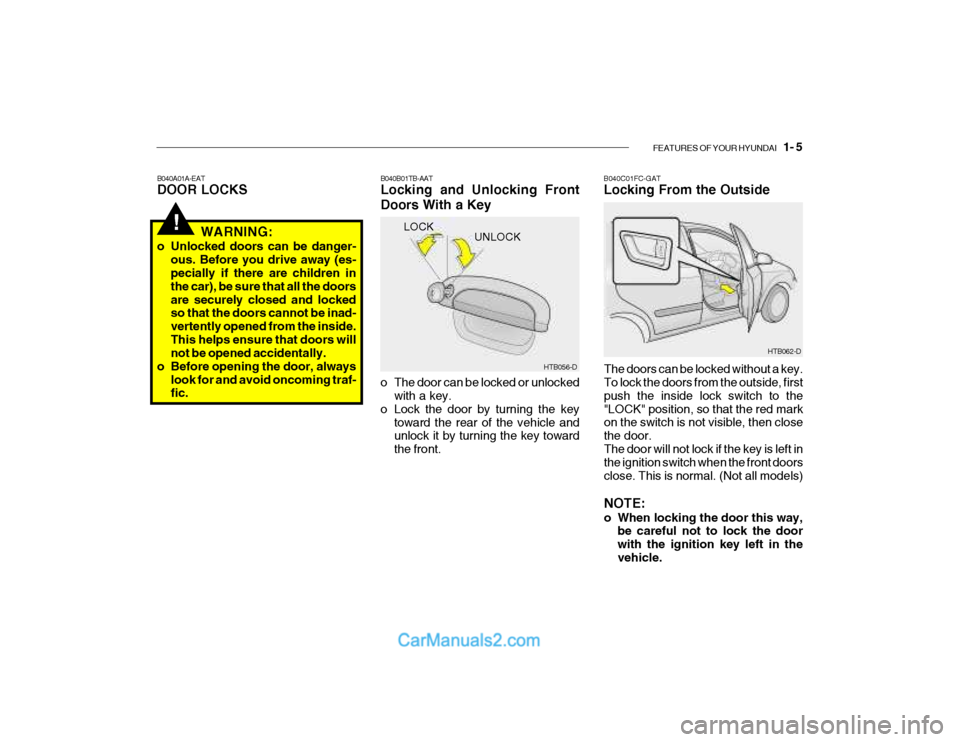
FEATURES OF YOUR HYUNDAI 1- 5
!
B040A01A-EAT DOOR LOCKS B040B01TB-AATLocking and Unlocking Front Doors With a Key
WARNING:
o Unlocked doors can be danger- ous. Before you drive away (es- pecially if there are children in the car), be sure that all the doorsare securely closed and locked so that the doors cannot be inad- vertently opened from the inside.This helps ensure that doors will not be opened accidentally.
o Before opening the door, always
look for and avoid oncoming traf-fic. o The door can be locked or unlocked
with a key.
o Lock the door by turning the key toward the rear of the vehicle andunlock it by turning the key toward the front. B040C01FC-GAT Locking From the Outside
The doors can be locked without a key. To lock the doors from the outside, first push the inside lock switch to the"LOCK" position, so that the red mark on the switch is not visible, then close the door.The door will not lock if the key is left in the ignition switch when the front doors close. This is normal. (Not all models) NOTE:
o When locking the door this way, be careful not to lock the door with the ignition key left in thevehicle.
UNLOCK
HTB056-D
LOCK
HTB062-D
Page 267 of 444

FEATURES OF YOUR HYUNDAI 1- 7
B070A01A-EAT ANTI-THEFT ALARM SYSTEM (Not all models) This system is designed to provide protection from unauthorized entry into the car. This system is operated inthree stages: the first is the "Armed" stage, the second is the "Alarm" stage, and the third is the "Disarmed" stage. Iftriggered, the system provides an au- dible alarm with blinking of the turn signal lights.
The central door locking is operated by pushing the driver's door lock switch toward the front or rear of the vehicle. Ifthe passenger and rear doors are open when the switch is pushed, the door will remain locked when closed. NOTE:
o When pushing the switch toward
the rear, all doors and tail gate will unlock. When pushing the switch toward the front, all doors and tail gatewill lock.
o When the door is unlocked, the
red mark on the switch is visibleand the character "LOCK" on the switch is visible.
o The central door locking is oper- ated by turning the key (with theft-alarm system: driver's door and passenger's door, without theft-alarm system: driver's door only) toward the front or rear of the vehicle. Park the car and stop the engine. Arm the system as described below.
1) Remove the ignition key from the
ignition switch.
2) Make sure that the engine bonnet and hatchback door are closed.
3) Lock the doors using the transmitter
of the keyless entry system.
After completion of the steps above, the turn signal lights will blink once toindicate that the system is armed. NOTE:
1) If any door, hatchback door or engine bonnet remains open, the system will not be armed.
2) If this happens, rearm the system
as described above.
CAUTION:
Do not arm the system until all pas-sengers have left the car. If the sys- tem is armed while a passenger(s)remains in the car, the alarm may be activated when the remaining passenger(s) leaves the car.
!
HTB052-D
B070B01O-EAT Armed Stage